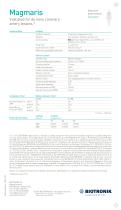
Catalog excerpts

Compelling safety data Fast Magnesium resorption time Better deliverability Vascular Intervention // Coronary Resorbable Magnesium Scaffold (RMS) Technical data / ordering info
Open the catalog to page 1
Why Magnesium? Magnesium alloy: favourable mechanical properties of a robust Magnesium backbone Robust Magnesium backbone The mechanical strength of Magnesium is superior to polymers like PLLA. Strain (%) Magnesium Stainless Steel Strong radial resistance No significant diameter change under increasing physiological pressure. Scaffold diameter (mm) Polymeric scaffold* Stable recoil M agmaris has a 38% lower recoil after 1 hour.2 Acute recoil Magmaris 3.0/20 Polymeric scaffold* 3.0/18 Recoil after 1 hour Magmaris 3.0/20 4 6 8 Proximal mean force (N) *Absorb, Abbott Rounded edges and smooth...
Open the catalog to page 2
Compelling safety data Confidence through evidence 12 months Definite/probable scaffold thrombosis Definite/probable scaffold thrombosis Definite/probable scaffold thrombosis Definite/probable scaffold thrombosis *Target Lesion Failure. Composite of cardiac and unknown death, target vessel myocardial infarction, clinically driven target lesion revascularization and CABG. **Patient underwent MIDCAB with subsequent DAPT interruption 5 days after the procedure.
Open the catalog to page 3
Fast resorption time ~95% of Magnesium resorbed at 12 months9 Immediately after implantation, struts are well apposed to the vessel wall. While the Magnesium resorption process continues, endothelialization progresses. At 12 months after implantation, the Magnesium resorption is almost completed. At 36 months the lumen is well preserved with a homogeneous surface.
Open the catalog to page 4
A more deliverable scaffold More than 70% of physicians who have used Magmaris RMS in clinical practice have rated the device to be better than a polymeric scaffold.11* Better lesion crossing Up to 40% lower lesion entry and crossing force.12 Lesion crossing ■ Magmaris ■ Polymeric scaffold* Lesion entry 42% less peak force. Stent/Scaffold strut thickness in perspective Polymeric scaffold* Stainless Steel DES** Polymeric scaffold* Better pushability 73% more force transmitted from hub to tip. Polymeric scaffold* Stainless Steel DES** * Absorb, Abbott ** BioFreedom, Biosensors
Open the catalog to page 5
Magmaris Indicated for de novo coronary artery Lesions.* Vascular Intervention Coronary Technical Data Scaffold Scaffold material Proprietary Magnesium alloy Markers Two tantalum markers at each end Active coating BlOlute (resorbable PoLy-L-Lactide (PLLA) eluting a Limus drug) Drug dose 1.4 pg/mm2 Maximum expandable diameter Nominal Diameter +0.6 mm Delivery system Catheter type Recommended guide catheter Crossing profile Guide wire diameter Usable catheter Length Balloon material Coating (distal shaft) Marker bands Proximal shaft diameter Distal shaft diameter Nominal pressure (NP) Rate...
Open the catalog to page 6All Biotronik catalogs and technical brochures
-
Orsiro
6 Pages
-
Pantera Pro
5 Pages
-
3Flow
2 Pages
-
PRO-Kinetic Energy
5 Pages
-
Passeo-35 HP
4 Pages
-
Pulsar-18
6 Pages
-
Galeo Pro
2 Pages
-
Fortress
3 Pages
-
Passeo-35
3 Pages
-
Passeo-18
3 Pages
-
Passeo-14
3 Pages
-
Conditions Overview
6 Pages
-
Closed Loop Stimulation
50 Pages
-
PK Papyrus
4 Pages
-
Astron
4 Pages
-
Pantera LEO
5 Pages
-
Lumax 740
1 Pages
-
BioMonitor
8 Pages
-
Protego
6 Pages
-
Idova 7
8 Pages
-
PRO-Kinetic
12 Pages
-
Magnum
2 Pages
-
Galeo
8 Pages
-
Streamer
2 Pages
-
AngioSculpt PTCA
2 Pages
-
BIOTRONIK Home Monitoring®
44 Pages
-
New Lease of Life
94 Pages
-
Pacemaker
48 Pages
Archived catalogs
-
Passeo-35 HP craking
3 Pages

































